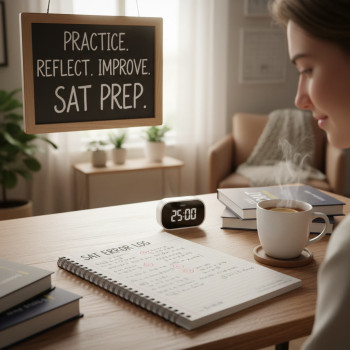Why grit and stamina matter for the Digital SAT
Think of the Digital SAT like a long run rather than a sprint. Yes, it’s shorter than older versions of the test and adaptive in new ways, but it still asks your brain to stay sharp, focused, and calm for a long, concentrated stretch. Grit — the ability to keep going when the task gets tough — and stamina — the energy and focus to sustain performance — are the secret weapons that separate practice-test scorers from real-test performers.
Building these qualities doesn’t mean grinding until you’re exhausted. It means training smart: creating habits, practicing under the right kinds of pressure, and giving your body and brain what they need to perform on the day that counts.
Start with a gentle diagnosis: where are you now?
Before you overhaul your routine, understand your baseline. Take a full-length, timed Digital SAT practice test using the official Bluebook-like setup or official practice on Khan Academy to mirror test conditions. Don’t treat this as a failure-or-success moment — treat it as data.
- Which section sapped your focus first — Reading & Writing or Math?
- Did your accuracy drop later in the test?
- Were there clusters of questions that consistently took too long?
Clues like these tell you whether you need stamina-building (longer sustained focus) or grit training (tolerance for frustration and harder problems), or both.
Build a weekly training plan that trains both skills
Consistency beats intensity. Small, regular habits compound into real stamina and grit. Here’s a simple, repeatable weekly framework you can modify for your schedule.
| Day | Focus | Duration | Goal |
|---|---|---|---|
| Monday | Timed practice set (30–45 min) | 45 min | Work on pacing |
| Tuesday | Targeted skill work (weak area) | 30–40 min | Master concepts |
| Wednesday | Endurance block (longer practice) | 90–120 min | Stretch focus and energy |
| Thursday | Mixed practice + review | 60 min | Build recovery routine |
| Friday | Mental rehearsal + light review | 30 min | Sharpen confidence |
| Saturday | Full-length practice test (digital format) | 2–3 hours | Simulate test day |
| Sunday | Rest and reflection | — | Recharge and plan |
That weekly rhythm mixes hard work with recovery. The “endurance block” and weekly full-length test are especially important: they teach your brain to maintain strategy and accuracy when fatigue begins to set in.
Small experiments that increase mental endurance
Grit grows through manageable challenges that stretch you just beyond your comfort zone. Try these micro-experiments and log how they affect your focus and performance.
- Progressive time-on-task: Start with a 25-minute focused session and add five minutes every week until you can do uninterrupted 90-minute blocks without losing accuracy.
- Difficulty ladders: Pick 10 problems slightly harder than your comfort level. Work through them without skipping. Track how often you finish without frustration pauses.
- Distraction practice: Practice in a mildly distracting environment (coffee shop noise app, light background conversation) to teach your attention to return quickly.
- Finish-the-set rule: If you start a timed set, finish it even if the score is poor — use the post-mortem to learn, not to judge.
Use realistic simulation: the Digital SAT habit
Simulate the actual experience: full start-to-finish runs on a laptop, tablet, or the testing app you’ll use. This isn’t just about content; it’s about getting your body, eyes, and nervous system used to the format. Include the same breaks, device setup, and even the way you eat beforehand.
During simulations practice these elements:
- Device setup & familiarity — practice using the tools the test provides (calculator features, highlight tools).
- Timing strategies — know how long to spend on a question before marking and returning.
- Comfort rituals — a short breathing routine or two-minute stretch between sections to stay physically flexible and mentally clear.

The science-backed routines that power stamina
Your brain is an organ with fuel needs and rhythms. Ignoring those will make even the best study plan underperform. Adopt routines that support cognitive endurance.
Sleep like your score depends on it
Because it does. Aim for consistent sleep, particularly the nights before long practice sessions and the test. Deep sleep helps consolidate memory and keeps reaction time sharp. Treat sleep as part of your study plan, not optional downtime.
Nutrition and micro-breaks
Fuel with complex carbs, protein, and hydration. On practice-test days avoid heavy meals that cause post-meal sluggishness. During long blocks, short breaks (3–5 minutes every 45–60 minutes) help reset attention. Try a two-minute walk, a quick stretch, or breathing exercises.
Movement and posture
Physical tension drains focus. Include daily movement — 20–30 minutes — and practice good posture during tests. Simple shoulder rolls and neck stretches during section breaks can prevent fatigue and keep blood flowing to your brain.
Sharpen grit with mindset and reflection
Grit isn’t stubbornness; it’s deliberate persistence plus reflection. The following practices strengthen that muscle:
- Failure logs: After each tough practice, write 3 things you learned and 2 concrete next steps. This turns frustration into fuel.
- Implementation intentions: Form specific plans like “If I get stuck on a question, I will mark it, skip, and return after two minutes.” Having a pre-decided plan reduces panic and keeps you moving.
- Celebrate micro-wins: Finishing a difficult section or improving timing by a minute is progress. Celebrate it briefly and then refocus on the next goal.
How to practice under pressure without burning out
We want pressure that stimulates, not overwhelms. Gradually increase stakes so your nervous system becomes comfortable performing when it matters.
- Start with low-stakes timed drills and add one higher-stakes session per week (full-length with an accountability partner or tutor watching the clock).
- Introduce realistic consequences — for example, make a small bet with a friend about improvement, or promise yourself a meaningful reward if you achieve a target score on a practice test.
- Debrief, then reset: Always close high-pressure sessions with a calm review and a relaxation ritual so stress doesn’t compound.
Smart homework: quality over quantity
Effective practice focuses on the highest-leverage areas. Use your diagnostic to pick targeted skills that will boost accuracy and speed.
- For Reading: practice active-scan strategies, passage mapping, and evidence linking.
- For Writing & Language: prioritize common grammar rules and rhetorical logic patterns.
- For Math: focus on algebraic manipulation, function interpretation, and identifying efficient solution pathways.
When a concept becomes automatic, it stops draining willpower — and that contributes dramatically to stamina on the long test day.
Use data to accelerate progress
Data tells you what to repeat and what to stop doing. Track metrics like accuracy by question type, average time per question, and decline in accuracy over time during long sessions. Every two weeks, review the trends and adjust your plan.
Sample 8-week program to build grit and stamina
This example assumes you’re 8 weeks from test day and can commit 8–12 hours per week. Tweak it based on your baseline and schedule.
| Weeks | Primary Focus | Weekly Structure |
|---|---|---|
| 1–2 | Baseline + habits | Diagnostic test, start 45-min focused sessions, 2 targeted skill days, weekend full-length simulation. |
| 3–4 | Stamina building | Increase endurance blocks to 75–90 minutes, weekly full-length test, review routines for sleep and nutrition. |
| 5–6 | Grit training | Introduce higher-difficulty sets, pressure drills, accountability sessions, and emotional regulation practice. |
| 7 | Polish and timing | Focused pacing practice, strategy refreshers, light review of weak spots, two full-length timed tests. |
| 8 | Taper and recovery | Short, focused reviews, maintain sleep routine, one simulation early in the week, rest and mental rehearsal before test day. |
How a tutor can speed up grit-building (and when to get one)
Working with a tutor is like having a training coach: they diagnose inefficient habits, give targeted exercises, and hold you accountable. If you find yourself stalled — stuck repeating the same errors or avoiding timed practice — a tutor can provide feedback loops that solo study often misses.
Sparkl’s personalized tutoring can fit naturally into this work: expert tutors provide tailored study plans, 1-on-1 guidance to troubleshoot persistent mistakes, and AI-driven insights to focus practice where it matters most. A good tutor helps turn practice into progress faster, and gives you a sounding board for the high-pressure parts of the prep journey.
Real-world examples: small changes, big effects
Two students illustrate how grit and stamina training look in the real world:
- Maya started missing accuracy in the last quarter of long tests. By adding weekly 90-minute endurance blocks and changing her lunch to protein and whole grains before practice, she stopped the late-test fade and moved her Reading score up by 50 points in six weeks.
- Jamal had test anxiety that made him freeze on tough questions. He used “implementation intentions” and practiced the skip-and-return rule until it became automatic. Paired with one month of tutor-led pressure simulations, he learned to move through hard questions calmly and improved pacing without sacrificing accuracy.

Test day checklist: bring your stamina, not surprises
On test day, the goal is to convert all the training into calm, steady performance. Here’s a checklist to reduce friction and preserve energy:
- Good night’s sleep (7–9 hours) the two nights before the test.
- Balanced breakfast 60–90 minutes before testing; bring a small snack and water if allowed by the testing instructions.
- Arrive early to set up your device and program, or make sure Bluebook (or testing app) is installed and updated ahead of time.
- Use your practiced breathing or two-minute stretch between sections.
- Stick to your skip-and-return rule for hard questions; avoid getting stuck.
- At the first sign of mental fatigue, use your micro-break (brief eyes-closed breathing) to reset attention.
Common pitfalls and how to avoid them
Overtraining
Long hours without strategic rest reduce returns. If your scores stagnate or drop, step back and swap a practice block for active recovery: sleep more, take a light exercise day, or do a no-phone afternoon.
Neglecting fundamentals
Chasing high-level strategy without closing basic gaps wastes grit. Combine endurance training with targeted skill work to ensure the basics become automatic.
Comparing yourself to others
Everyone’s journey is different. Use benchmarks and personal data to judge progress, not social media highlight reels.
Final thoughts: grit is a practice, not a trait
If grit sounds like an innate quality you either have or don’t, flip the script. It’s a practiced response — a series of small choices and habits that directionally improve how you handle challenge. Start small, track honestly, and iterate.
Remember: stamina on test day is the compound interest of months of smart habits. Keep sleep, nutrition, short focused practice, and reflection central to your plan. If you find yourself needing tailored guidance, a personalized tutor can help focus your effort. Sparkl’s personalized tutoring, for instance, offers 1-on-1 guidance, tailored study plans, and AI-driven insights that many students find helpful for turning hard practice into steady score gains — but the real power comes from your daily habits and mindset.
Quick reference: 10 practical actions to start today
- Take one full, timed digital practice test this week to set a baseline.
- Create a weekly schedule that mixes short focused sessions with one endurance block.
- Introduce a 3–5 minute reset routine between sections.
- Practice the skip-and-return rule until it’s automatic.
- Track accuracy and time on question types, and review weekly.
- Gradually increase timed session length by 5–10 minutes per week.
- Prioritize consistent sleep and balanced meals on practice days.
- Use mild distractions in practice to train attention resilience.
- Log failures as lessons with two concrete next steps.
- Consider short-term tutoring if progress stalls — focus on targeted fixes rather than more hours alone.
Parting encouragement
Building grit and stamina is quieter work than cramming for one night, but it is far more effective. Each focused practice session, each deliberate review, and each moment you choose a short rest over a useless marathon adds up. You don’t have to become perfect — you need to become reliably resilient. Start with one small habit today, and give yourself the gift of consistent, steady progress toward the Digital SAT.
You’ve got this. Take a breath, set the timer, and begin.

















No Comments
Leave a comment Cancel